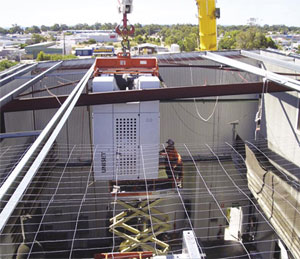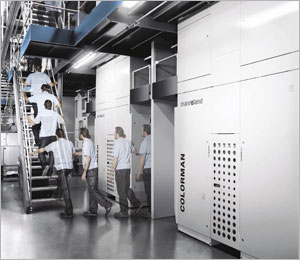Groundbreaking manroland
newspaper technologies spreading worldwide
Undoubtedly, manroland’s newspaper printing presses provide the suitable solution for every demand anywhere, resulting constant increase in their installation base across the globe. Their latest installations cover Sweden, France, China and Australia with groundbreaking newspaper printing technologies replacing older manroland or competitor presses.
 The UNISET towers being delivered to Fairfax Media printing plant
in Mandurah/Australia.
The UNISET towers being delivered to Fairfax Media printing plant
in Mandurah/Australia.
|
Braving the elements to print one of the world’s oldest newspapers, manroland is presently installing latest technology with a REGIOMAN press at Pressgrannar AB in Linköping/Sweden: next to other dailies, different freesheets, and tabloid commercial products, the REGIOMAN will soon produce the daily Norrköpings Tidningar. It was founded in 1758 which makes it one of the world’s ten oldest newspapers. “To make room for the REGIOMAN we enlarged the pressroom by twelve meters,” says Peter Dahlén, project manager at Pressgrannar. The first part of the REGIOMAN with three printing towers and one folder has already been installed. Then the old press will be taken out and the second part of the REGIOMAN will move in. The final configuration features six reel splicers, six printing towers, and two folders.
Providing more colour
with less presses!
Working with manroland presses since 1985, the Telegraaf Media Groep (TMG) now wants more and less at the same time: more colour, less presses. But it poses no problem for the newspaper technology expert manroland. “After the upgrade TMG’s products will be printed economically and in top quality provided by manroland’s latest technology. We are sure our readers and advertisers will highly appreciate the full colour appearance throughout the newspaper,” says Harold Tamminga, print director at TMG.
De Telegraaf, the Netherland’s largest morning paper with a daily circulation of around 700,000 copies, today operates ten TELEMAN presses. Starting in 1985 six so-called TELEMAN presses were installed, which are based on the manroland COLORMAN concept but featuring reel splicers and printing units at a 90 degree angle at ground level, at that time with a full colour capability of 12.5 percent. In 1991 three additional TELEMAN presses were installed and the existing presses were upgraded to 25 percent full colour capability. In 2001, the tenth TELEMAN was installed and all existing presses were upgraded to 50 percent full colour capability. Now in 2011, Telegraaf has decided to upgrade all presses to 100 percent full colour and reduce the number of presses to seven, configured for 32 or 48 pages. The process leading up to this project focused on finding the most economical way to create full colour throughout the whole newspaper.

“In a joint effort between manroland and TMG a solution was found to produce the same quantity of newspapers in full colour on seven instead of the current ten presses,” says manroland project manager Sixten Zapf. The required extra colour is generated by using components from the future obsolete presses, the quality of the existing components still meets today’s standards. To facilitate the transfer process and ensure that daily newspaper production can continue manroland will deliver four additional satellite printing towers. Moving the components and connecting older shaft-driven with new single-motor driven printing units requires a complete renewal of the cabling and the electronic equipment. This comprehends a major PECOM upgrade within the manroland printnet networking system.
|
Enjoying the applause while replacing first COLORMAN after 34 years, the part of a technical modernization programme is the GEOMAN sale to Groupe Nice Matin in Nice in the South of France. Three GEOMAN presses are going to replace Nice Matin’s COLORMAN printing system which was installed in 1977 – manroland’s first COLORMAN in the market – and extended during the following ten years. Now, latest GEOMAN technology is taking over, with each of the three presses consisting of three reel splicers, three eight-couple towers, one folder, and PPL (PowerPlateLoading), the highly automated plate changing device. Its higher efficiency and full-colour capacity will print Nice Matin’s versatile product range economically and in high quality. It will generate more contract printing business than before.
The company further enlarged their base in China by installing latest UNISET technology at the Xin’an Media Corporation in Hefei, the capital of the Anhui province. The new press started producing at the beginning of the year 2011 and now prints 20 different newspapers, magazines, advertising material and books. It is China’s first 80,000 copies per hour UNISET featuring three reel splicers, three printing towers, one dryer, and two folders, one of them with a 16-page device. Xin’an Media Corporation is a joint venture of the Anhui Daily Newspaper Group and the South African MIH Print Media Group. The company was decorated for innovation and quality several times and its printing center with plants in Hefei, Huangshan and Fuyang is one of the most advanced in Mainland China. Besides, already working with four UNISET presses since 2004, the Sichuan Ribao Newspaper Group in Chengdu (China) ordered two new UNISET printing systems in the middle of 2010 featuring 80,000 copies per hour. Equipped with five reel splicers, four printing towers, two folders, and a dryer, the new presses have arrived in Chengdu by mid May this year.
About 100 kilometers south of Perth (Australia) rests the city of Mandurah, famous not only as a resort town but also as the home of the westernmost Fairfax Media printing plant which has invested in a major upgrade in pagination capacity by expanding the existing manroland UNISET press. Stage one commences with the installation of two new eight-couple towers, two additional reel splicers and a further folder. The completion of stage one will see the plant with six towers and two folders providing the increase in capacity sought, plus a major increase in flexibility for the coldset plant. Stage two will see the introduction of heatset capacity. An additional eight-couple tower with a dedicated reel splicer and a MEGTEC dryer will be installed. This will enable the production of glossy publications or inserts and an ability to mix heatset and coldset production.
 The UNISET towers being delivered to Fairfax Media printing plant
in Mandurah/Australia.
The UNISET towers being delivered to Fairfax Media printing plant
in Mandurah/Australia.
